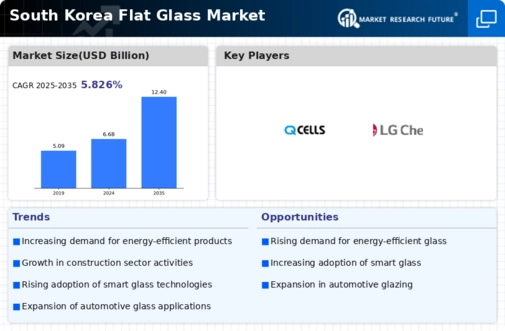The South Korea Flat Glass Market has experienced significant evolution, characterized by technological advancements and increasing demand from various sectors such as construction, automotive, and renewable energy. The competitive landscape includes key players who have established their presence through innovation, strategic partnerships, and robust distribution networks. Companies in this market are vying for a larger share by enhancing their product offerings, focusing on sustainable manufacturing processes, and expanding their geographical reach.
The clear segmentation of the market, driven by the demand for energy-efficient and aesthetically pleasing glass solutions, has prompted firms to differentiate their products and services to cater to diverse consumer needs. Understanding the competitive dynamics is crucial for market participants seeking to navigate through the complexities of this vibrant sector. Samsung Glass has solidified its position in the South Korea Flat Glass Market through continuous innovation and a commitment to quality.
Known for its diverse range of flat glass products, Samsung Glass leverages advanced manufacturing technologies to create high-performance glass suitable for a variety of applications, including commercial and residential buildings. The company’s extensive distribution network ensures availability across the nation, making it a go-to choice for architects and developers. Its strengths lie in its strong brand reputation, investment in research and development, and commitment to sustainability, which resonate with the growing consumer preference for eco-friendly products.
The synergy within the conglomerate also allows Samsung Glass to access advanced technologies and resources, ensuring its competitive edge remains sharp in the local market. Hanwha Q CELLS, while primarily recognized for its solar energy solutions, has made significant strides in the South Korea Flat Glass Market by integrating photovoltaic technologies into its product line. The company's focus on renewable energy aligns with market trends favoring sustainable building materials. Hanwha Q CELLS offers specialized flat glass products designed for solar panels, enhancing their efficiency and performance.
Its notable strengths include a strong research and development team dedicated to innovation, as well as strategic partnerships that bolster its market presence. The company has strategically engaged in mergers and acquisitions to expand its technological capabilities and market share, allowing it to remain competitive in a rapidly changing environment. Hanwha Q CELLS’ dedicated approach to both flat glass and renewable energy solutions positions it effectively within the South Korean market, making it a crucial player in the intersection of glass technology and sustainable energy.













Leave a Comment